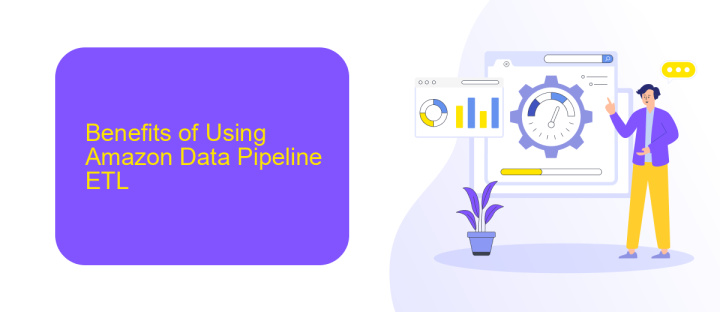Amazon Data Pipeline ETL
Amazon Data Pipeline is a robust ETL (Extract, Transform, Load) service that enables seamless data processing and movement across AWS services. It simplifies complex workflows by automating data-driven tasks, ensuring data integrity and efficiency. Ideal for businesses of all sizes, this service facilitates the integration, transformation, and analysis of data, empowering organizations to make informed decisions.
Introduction to Amazon Data Pipeline ETL
Amazon Data Pipeline ETL is a robust service designed to facilitate the extraction, transformation, and loading of data across various AWS services. By automating data workflows, it ensures seamless data transfer and processing, enabling businesses to focus on deriving insights rather than managing data logistics.
- Automates data movement between different AWS services and on-premises data sources.
- Ensures data is processed and transformed according to predefined business rules.
- Supports complex data workflows with built-in scheduling and dependency management.
- Offers reliability and scalability to handle large volumes of data efficiently.
For those looking to integrate Amazon Data Pipeline ETL with other applications or services, tools like ApiX-Drive can be invaluable. ApiX-Drive simplifies the integration process, allowing users to connect various data sources and services without extensive coding. This ensures that data flows smoothly between systems, enhancing overall data management and operational efficiency.
Benefits of Using Amazon Data Pipeline ETL

Amazon Data Pipeline ETL offers a robust and scalable solution for data processing and transformation. One of its primary benefits is the ability to automate and schedule complex workflows, ensuring that data is consistently and accurately processed. This automation reduces manual intervention, minimizing the risk of human error and freeing up valuable time for data engineers to focus on more strategic tasks. Additionally, Amazon Data Pipeline integrates seamlessly with other AWS services, such as S3, RDS, and Redshift, providing a cohesive ecosystem for end-to-end data management.
Another significant advantage is its flexibility in handling diverse data sources and formats. With Amazon Data Pipeline, businesses can effortlessly integrate data from various sources, whether on-premises or in the cloud. For those looking to streamline their integration processes further, services like ApiX-Drive can be invaluable. ApiX-Drive allows for easy setup and management of integrations, ensuring that data flows smoothly between systems without the need for extensive coding. This combination of Amazon Data Pipeline and ApiX-Drive ensures a reliable, efficient, and scalable ETL solution for any organization.
How Amazon Data Pipeline ETL Works

Amazon Data Pipeline ETL (Extract, Transform, Load) is a managed service that helps automate the movement and transformation of data between different AWS services and on-premises data sources. The service ensures reliable data processing, making it easier to manage complex data workflows.
- Extract: Data is extracted from various sources such as RDS, DynamoDB, S3, and on-premises databases. This step involves connecting to the data sources and retrieving the necessary data.
- Transform: The extracted data is transformed using predefined business rules or custom scripts. This step may include data cleaning, filtering, aggregation, and enrichment.
- Load: The transformed data is loaded into target data stores like Redshift, S3, or other databases for further analysis and reporting.
To streamline the integration process, services like ApiX-Drive can be used. ApiX-Drive simplifies the setup of data pipelines by providing a user-friendly interface to connect various data sources and destinations without the need for extensive coding. This makes it easier to automate and manage data workflows efficiently.
Building an ETL Pipeline with Amazon Data Pipeline

Building an ETL pipeline with Amazon Data Pipeline involves several steps to ensure smooth data extraction, transformation, and loading processes. First, you need to define the data sources and destinations, which can include Amazon S3, RDS, DynamoDB, and Redshift. Properly configuring these sources and destinations is crucial for the pipeline's success.
Next, you will create a pipeline definition, which outlines the tasks and schedules for data processing. This involves specifying the data nodes, activities, and preconditions. You can use the AWS Management Console, CLI, or SDKs to define and manage your pipeline. Additionally, integrating third-party services like ApiX-Drive can help streamline the process by automating data transfers between various platforms.
- Define data sources and destinations
- Create a pipeline definition
- Specify data nodes, activities, and preconditions
- Use AWS Management Console, CLI, or SDKs for management
- Consider integrating ApiX-Drive for automation
Once your pipeline is defined, you can schedule it to run at specific intervals or trigger it based on certain conditions. Monitoring and logging are essential for ensuring the pipeline's efficiency and troubleshooting any issues that arise. By leveraging Amazon Data Pipeline and tools like ApiX-Drive, you can build a robust ETL solution tailored to your data processing needs.
Best Practices for Amazon Data Pipeline ETL
When setting up Amazon Data Pipeline for ETL processes, it is crucial to design your pipeline with modularity and scalability in mind. Break down your tasks into smaller, manageable components to facilitate easier debugging and maintenance. Use parameterized templates to ensure flexibility and reusability, which can save time and effort when deploying similar pipelines across different environments. Additionally, make sure to set up proper logging and monitoring to quickly identify and address any issues that may arise during data processing.
Integrating third-party services can further enhance the efficiency of your ETL processes. For instance, using ApiX-Drive can simplify the integration of various applications and data sources, enabling seamless data flow between them. This can be particularly useful for automating data transfers and ensuring data consistency across different platforms. Always test your pipeline thoroughly in a staging environment before deploying it to production to minimize the risk of errors and ensure smooth operation.
FAQ
What is Amazon Data Pipeline?
How does Amazon Data Pipeline ensure data processing reliability?
Can Amazon Data Pipeline integrate with other AWS services?
How can I automate and integrate Amazon Data Pipeline with external services?
What are the main use cases for Amazon Data Pipeline?
Do you want to achieve your goals in business, career and life faster and better? Do it with ApiX-Drive – a tool that will remove a significant part of the routine from workflows and free up additional time to achieve your goals. Test the capabilities of Apix-Drive for free – see for yourself the effectiveness of the tool.

